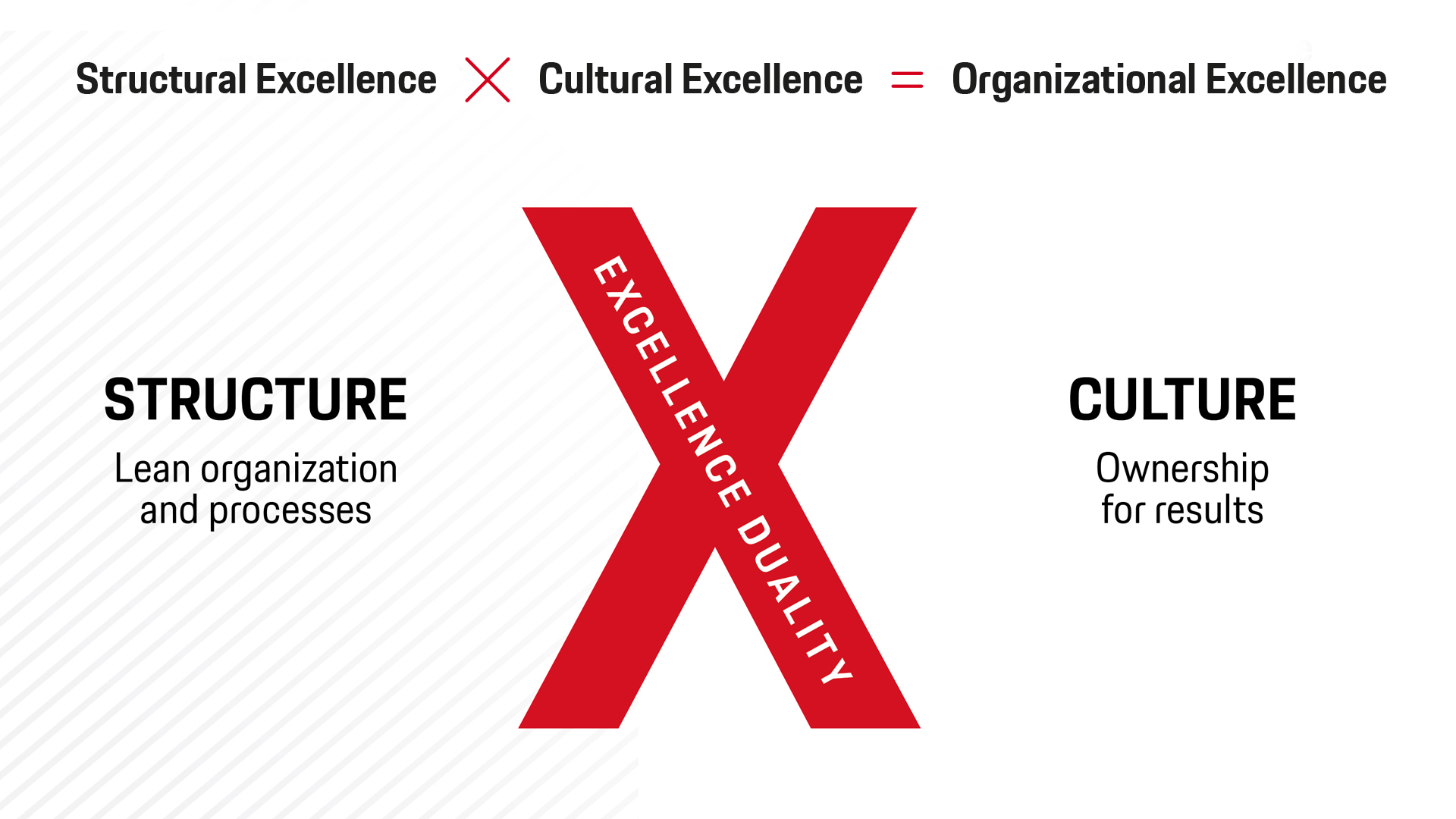Multiplying Structure
by Culture
Many companies are currently undergoing restructuring processes. The measures they take are sometimes tough, especially for the people involved, their employees. A strong and suitable culture is needed as the foundation in order for the new superstructure to be stable and resilient.
11/2024

Large parts of the German economy are in a difficult period that is “first and foremost a structural crisis,” writes the Munich-based ifo Institute for Economic Research in its “Economic Forecast Autumn 2024.” A wave of structural adjustments is underway, with head offices under enormous strain. Costs and benefits are being scrutinized as closely as positions and organizational charts. As observed by the Porsche Consulting management consultancy, top-level managers at large corporations are hard at work on structural changes. They have long since recognized that previous formulas for success are no longer applicable. Rigorous programs are being launched everywhere. Most involve new structures that first need to be created.
New structures—what do they mean for the organization as a whole? For one thing, they disrupt the previous routines followed by employees in all parts of the company. Routines that used to provide stability and security, but might not have been examined intensively for quite a while. And then comes the day of reckoning. A tough cut. When a company restructures, it may well end up with fewer hands on deck. That compels its employees to reorganize, become more productive, and generally also assume more responsibility. Each individual is now called upon more than ever before. On top of that, an entirely new mindset is often expected as well.
Key concept: High-performance culture
For many people, periods such as these feel like sailing into uncharted waters. Concerns arise. Uncertainties spread. Who will provide solid guidance? What can now inspire confidence?
Companies in transformation find themselves at a critical juncture for their corporate cultures. The structural measures they undertake have a substantial impact on employee behavior, on individuals, teams, and collaboration as a whole. Company leaders should now actively shape and build their cultures to support their strategic courses and goals. It is crucial to prevent the corporate culture from developing in the wrong direction in an uncontrolled way—or in other words, to prevent a cultural accident. The aim now is to make use of what is actually a window of opportunity.
A company’s culture figures prominently in the success of its structural changes. These cultures now need to be actively reshaped, carefully cultivated, and embraced by leaders on all levels. Many managers are acutely aware of this. According to an analysis by Porsche Consulting, 83 percent of board members at the top 40 companies on the German stock index (DAX) are striving for a high-performance culture in order to safeguard their competitiveness in the future. Yet teams from Porsche Consulting have also noted that most of the activities these companies undertake tend to fizzle out in practice.

Simple equation, strong result
A simple and illuminating equation can facilitate a successful outcome: “structural excellence times cultural excellence equals organizational excellence.” Lean structures and processes coupled with individual responsibility for the results—these two factors yield a strong formula. Of course, organizational excellence or what is meant by “high performance” needs to be defined for specific cases. During the course of working with its clients, Porsche Consulting has developed and repeatedly tested a general formula. It lends itself to practice, is well received at companies, and works. At its heart are “the will and ability of an organization and its employees to consistently achieve precisely the right high performance—in a sustainable manner.”
Anyone who focuses on high performance realizes that excellence is always accompanied by change. Most companies have a great need for change. That is confirmed by the Change Management Compass, for which Porsche Consulting surveys leadership personnel from Germany’s top 100 companies every two years. And in fact, 66 percent of respondents in 2022 expressed a desire to change their companies in fundamental ways over the following two years. But the most recent survey, in 2024, revealed that 69 percent of the transformation projects had failed. That does not bode well for organizational excellence, which is precision work—and a goal that can only be achieved if everyone on all levels works together with a high degree of commitment.

Excellence begins with each employee, with each individual. For instance, with the question of what type of attitude employees and their supervisors bring to work at the start of their day. It also includes the atmosphere awaiting them in their professional context. People are motivated when they can make contributions, develop as individuals, be seen, and feel valued. Here too, the survey of managers at the top 100 companies yields a critical result: only 53 percent of respondents stated that everyone at their company appears willing to go the extra mile, day in and day out. Most of their employees are motivated and committed in principle, the managers say. But their energy is not put to the best possible use in fostering collaboration, pursuing the company’s strategies, and achieving its goals.
“We before I”
The next level up is that of teams. High-performance organizations are guided by a “we before I” principle. Every team member needs to know their role in the organization, and the shared aim. The consultants have observed that collaboration usually works smoothly between clearly defined teams from the same department. During periods of transformation, however, there is an increased demand for interdisciplinary project teams and cross-functional collaboration. The question of resource allocation often leads to contention and controversy. Only 44 percent of the managers surveyed stated that strong interdepartmental collaboration is evident in their organizations.
The third level—that of the company itself—is formed by the sum of the teams. It thrives on entrepreneurial thought or “ownership.” Each employee should act as if the company were their own. But it is not uncommon for this principle to fall by the wayside, especially in what are often complex organizations. Here only 18 percent of respondents from the top 100 companies stated that they are transferring an increased level of decision-making authority to teams and individuals in order to foster entrepreneurship. And only 26 percent consider their organizations sufficiently flexible and agile to allocate resources based on need.
In order to achieve and maintain long-term organizational excellence, a company needs to communicate its strategies, aims, and values transparently and continually to all its employees. This can be done on a stepwise basis. Workshops, townhall meetings, and team discussions can start the process for mid-level management. The next step consists of bringing all the employees on board. Leadership personnel on all levels are then called upon to explain, answer questions, and convince their people, also in smaller groups. Two points are crucial here. First, repetition is nothing to be feared. For a culture to be influenced, it needs to appear regularly on the agenda. And second, top-level managers need to speak with one voice, send consistent messages, and demonstrate a high degree of unity to their workforce.
Communication alone is not sufficient, however. Success depends above all on leadership personnel truly embracing their company’s cultural values. Leaders who demand a team spirit from their staff members should possess this quality themselves and show it in authentic ways. This, unfortunately, has still been lacking too often in practice. At companies without a demonstrated high-performance culture, only 42 percent of their leadership personnel show commitment and collaboration themselves, compared to 61 percent at companies that do have this culture.
More on this topic in the strategy paper „High Performance Culture“.
About the author

